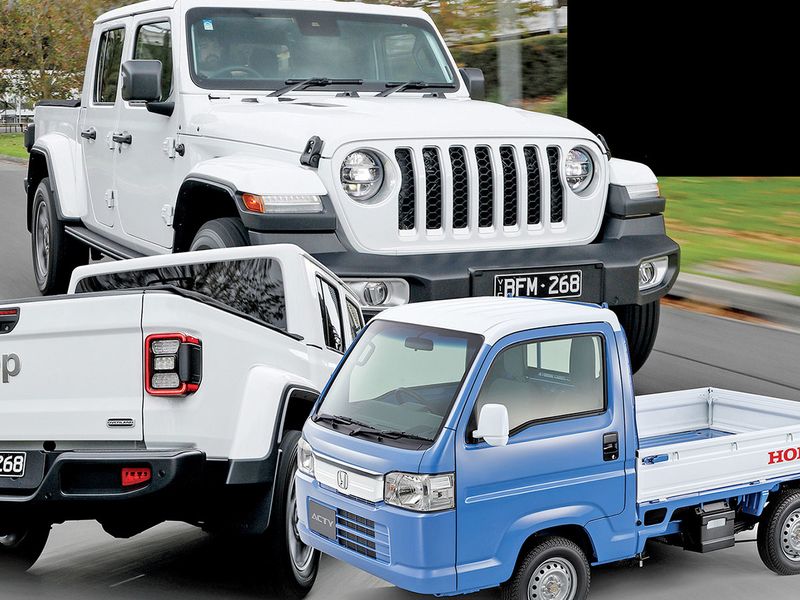
SHIMUKAPPU, Japan — Japanese roads are packed with their share of eccentric automobiles. The look of pint-sized minicars, skinny tall vans and hybrids galore may take overseas visitors by surprise.
But another vehicle will soon cause even the locals to do a double take — American-style pickups.
Few and far between on this country’s byways, pickups seem absolutely anathema to Japanese tastes. But Jeep wants to jolt the status quo with its Gladiator. Jeep plans to introduce the Wrangler-based truck to Japan toward the end of this year, becoming what is believed to be the first U.S. brand in recent memory to directly import that most American of American vehicle types.
Jeep is counting on the Gladiator to help lift sales in this country to new heights. Targeting its eighth-straight year of record sales in Japan this year, Jeep wants to sell more than 20,000 vehicles annually in this notoriously finicky market in 2023, up from just more than 5,000 in 2013.
To get there, Jeep is expanding its dealer network and its offerings. Thus, enter the Gladiator.
Pontus Haggstrom, CEO of FCA Japan, doesn’t expect Jeep’s Gladiator experiment to trigger a pickup boom anytime soon in Japan. For the most part, not even Japanese brands compete in the segment.
But Jeep’s gambit comes as U.S. brands rethink Asian appetites for bed-in-back vehicles in other markets, most notably China. Increasingly, they trade on upmarket allure over workaday utility.
In recent years, pickup sales ticked upward in China as the government, always concerned about congestion and pollution, deregulated restrictions on where the light trucks could operate. Once used to carry cargo, they are now increasingly used to transport people. And like their American counterparts, Chinese consumers increasingly see pickups as an image vehicle.
Great Wall Motor Co., by far China’s top pickup manufacturer, booked big orders for its new P pickup, thanks to a strategy of pitching it as a vehicle for families. It was the first pickup from a Chinese brand to be classified as a passenger vehicle, instead of a utilitarian workhorse.
Tapping that trend, Ford began selling its F-150 Raptor in China several years ago, and Chevrolet followed with exports of its Silverado and Colorado pickups.
In China, those U.S. entrants are still perceived mostly as luxury toys. And that is largely the positioning Haggstrom envisions for the Gladiator in Japan — a unique sporty status symbol for those who fancy an active, outdoorsy lifestyle and relish standing out in a crowd.
He thinks Jeep can sell several hundred Gladiators a year in Japan. Those are meager numbers compared with U.S. volumes, but the Gladiator could burnish the brand and push overall volume toward Jeep’s sales goal.
“For us, it’s a brand statement,” Haggstrom said of the Gladiator at a Jeep snow drive event this month on Japan’s northern island of Hokkaido. “It’s the ‘wow!’ of the ‘wow!’ ”
Jeep’s Japan boss imagines Japanese customers throwing their ski or surfing equipment in the back, or weekend warriors hauling firewood to their cabin in the mountains.
Haggstrom asked headquarters back in 2019 to send the Gladiator to Japan.
“I think they were surprised when we came with the request,” he said. But there was hardly any blowback from executives in Auburn Hills, Mich.
“We figured, why not?”
Jeep expects the Gladiator to springboard off the soaring popularity of the Wrangler. Sales of the iconic Wrangler have risen for 11 straight years, from just 516 in 2009 to 5,757 in 2020. The nameplate vaulted Jeep to total brand sales of 13,588 in 2020, despite the pandemic.
Japan is now Jeep’s No. 6 market worldwide. But the brand must invest to keep it that way. And that meant prepping the Gladiator for battle in one of the world’s most demanding consumer cultures.
“We wanted it engineered for us,” Haggstrom said.
Work included ensuring a right-hand-drive version for Japan. Engineers also had to tweak the instrument cluster, the lighting and the navigation. Even the key fob uses a different wireless frequency in this country.
“These sound like trivial things, but there are a ton of them,” Haggstrom said of the tweaks for Japan.
Even though the Gladiator is not a full-size truck, pickups of any stripe are mavericks in Japan.
Gray imports of big trucks, such as a left-hand-drive Toyota Tundra or even the odd Ram pickup, are occasionally spotted on the loose. But they invariably look out of place on Japan’s narrow roads, surrounded by minicars, some of which could almost fit in the bed.
Toyota is the only Japanese pickup player in the domestic market. It imports its popular Hilux from Thailand. Japan’s biggest automaker sold 6,300 Hilux pickups in Japan last year.
Mitsubishi, known for its Triton pickup in Southeast Asia, doesn’t dabble in the segment at home. Nissan ended production of its Datsun pickup for domestic sales in 2002. And Mazda, which once sold its Familia and Proceed pickups here, pulled the plug as well.
Subaru never sold any pickup in Japan, not even its Brat compact car-utility vehicle. The same goes for Honda.
Indeed, for Japanese people who need some carrying capacity, the ubiquitous flatbed minitrucks seem to do the trick for most. But Jeep has different ideas for its four-door Gladiator.
“Some people will never use the back,” Haggstrom said. “They’ll just drive it because it’s cool.”